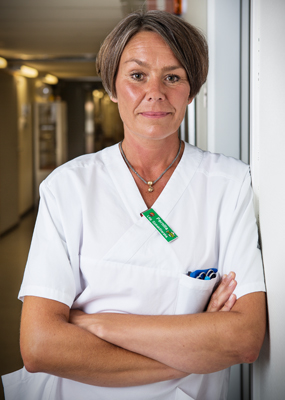Effects of noise and stress in healthcare
Pernilla Svensson is a registered nurse, with a master’s degree in cardiovascular care, in Klippan, near Helsingborg in southern Sweden. For the past 20 years, she has worked in a variety of hospital settings.
 ECO for Sustainable Design filmed her sharing some of her experiences regarding the working environment in the healthcare sector. You’ll find a selection of quotes from the video below and the video at the bottom of this page.
ECO for Sustainable Design filmed her sharing some of her experiences regarding the working environment in the healthcare sector. You’ll find a selection of quotes from the video below and the video at the bottom of this page.
On noise levels in the healthcare sector:
“Everything from technical equipment to other members of staff around me, patients, family members, phones ringing. There’s a great deal of workplace noise in the healthcare sector.”
On technical aids:
“Technical aids are an essential part of modern-day healthcare, making patient care more efficient. However, they do produce a lot of sounds and noises, for instance in a cardiac intensive care unit where patients are hooked up to the machine 24 hours a day. There are blood pressure cuffs, thermometers and all kinds of other machines that are constantly dinging. All the equipment we use these days produces noise. But it’s essential.”
On the effects of all this noise on staff:
“There is certainly a risk that you might make a wrong decision. You can’t make sense of prescriptions, you get stressed, and you might experience physical symptoms such as palpitations and dry mouth.”
“Noise has a huge effect on the working environment in a hospital ward or emergency department. I doubt whether, as a nurse, you actually stop to consider how all the noise surrounding you every day is affecting your work environment. But once the question has been raised, you quickly become aware of how much it affects you.”
“The acoustic environment makes a big difference to patients and staff alike. Especially in a hospital, where most departments – such as emergency – have an open-plan layout with everyone in the same space. There are computers, nurses, doctors, patients, family members, technical equipment, all in one big crazy mix. In the midst of all this, you’re expected to focus, make the right decisions, understand prescriptions correctly, and so on. This affects patients and staff alike.”
On using your voice as a clinical tool:
“A voice can have either a positive or a negative effect on a patient. If you speak calmly and quietly, remembering to lower your voice, not to speak too loudly, to sound subdued rather than shrill, then this can have a calming, reassuring effect on patients.”
On the therapeutic use of sound:
“In healthcare we also make use of sound in a positive way. In a waiting room, for example, you can have pleasant background music that makes patients feel more comfortable and relaxed. And for some diagnostic imaging procedures that require patients to lie still for a time, you can offer them headphones and their choice of music.”
On involving the staff in a construction project:
“You should allow members of staff who go to work every day in the various departments to be involved in modification and renovation projects. That would surely yield very positive results.”
Watch the full interview with Pernilla Svensson
Photo: Lars Jansson
